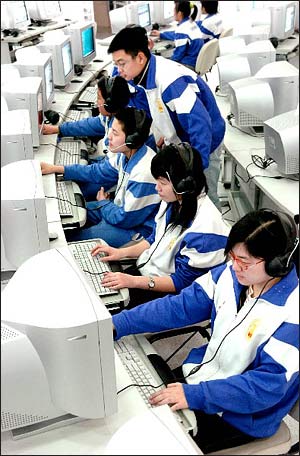| Home / 2006 China in Brief / Education | Tools: Save | Print | E-mail | Most Read |
| Development |
| Adjust font size: |
Since 1950 China has provided nine-year compulsory education for a fifth of the world's population with only two percent of the world's total education spend. It has the world's largest number of people receiving education, over 300 million. Net elementary school enrollment has reached 99 percent, and gross enrollment rates in junior high schools, senior high schools, and higher learning institutions are 95 percent, 53 percent and 21 percent, respectively. Nine-year compulsory education operates in over 95 percent of China's populated areas, illiteracy in the young and middle-aged population is under four percent, and education in China has reached the average level for middle-income countries. China's educational horizons are expanding. Before 1990, the MBA degree (Master of Business Administration) was virtually unknown, but by 2005 there were over 50,000 MBAs trained at 62 MBA schools. Many apply for international professional qualifications, such as EMBA and MPA; close to 10,000 MPA students are enrolled in 47 institutions of higher learning, including Peking University and Tsinghua University. The education market has rocketed, with training and testing for professional qualifications, such as computer and foreign languages, thriving. Continuing education is the trend; once in one's life schooling has become lifelong learning. International cooperation and education exchanges increase every year. China has more students studying abroad than any other country. Since 1979, there have been more than 700,000 Chinese students studying in 103 countries and regions, of whom nearly 200,000 have returned after finishing their studies. The number of foreign students studying in China has also increased rapidly; in 2004, over 110,000 students from 178 countries were studying at Chinese universities. Investment in education has increased in recent years; the proportion of the overall budget allocated to education has been increase by one percentage point every year since 1998. According to a Ministry of Education program, the government will set up an educational finance system in line with the public finance system, strengthen the responsibility of governments at all levels in educational investment, and ensure that their financial allocation for educational expenditure grows faster than their regular revenue. The program also set out the government's aim that educational investment should account for four percent of GDP in a relatively short period. For non-compulsory education, China adopts a shared-cost mechanism, charging tuition at a certain percentage of the cost. Meanwhile, to ensure that students from low-income families receive education, the government has initiated effective ways of assistance, including scholarships, work-study programs, subsidies for students with special economic difficulties, tuition reduction or exemption and state stipends. The government is committed to providing more educational opportunities and markedly raising educational levels generally over the next two decades. As evidenced in a Ministry of Education program, by 2020, of every 100,000 people, 13,500 will have had junior college education or above, and some 31,000 will have had senior high school education; rates for illiteracy and semi-literacy will fall below three percent; and average schooling duration across the population will increase from today's 8.5 years to nearly 11 years. |
| Tools: Save | Print | E-mail | Most Read |
 |
| Related Stories |
